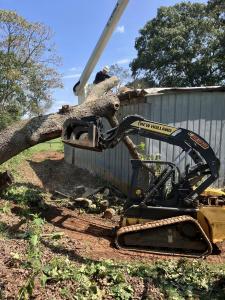
Why Late-Winter Pruning is Essential: Expert Insights from Hollar Brothers Tree Service
Before the buds break and new leaves unfurl, there’s one important task that shouldn’t be overlooked—tree care.
HICKORY, NC, UNITED STATES, February 12, 2025 /EINPresswire.com/ -- February Marks Prime Time for Tree Prep—Here’s Why Experts Recommend Acting Now.As winter winds down in North Carolina, many homeowners shift their focus to gardens and landscaping, eager for the first signs of spring. But before the buds break and new leaves unfurl, there’s one important task that shouldn’t be overlooked—tree care. Late winter, particularly February, is the perfect time for pruning, inspecting, and preparing trees for a season of healthy growth.
Ignoring tree maintenance now can lead to weakened limbs, disease spread, and a higher risk of storm damage when spring showers and summer storms arrive. A little proactive care today can save both money and headaches down the road.
Pruning Now Means Stronger Growth Later
Winter dormancy is a tree’s natural reset period. With growth slowed and leaves absent, pruning is less stressful for the tree and easier for homeowners or professionals to assess structure and remove problem branches.
Certain trees—like oaks, maples, and fruit-bearing varieties—particularly benefit from late-winter pruning. Waiting too long can lead to excessive sap loss in early spring, while pruning too early in the fall leaves open wounds susceptible to disease.
Spot Tree Health Issues Before It’s Too Late
Late winter is also the best time to assess trees for hidden dangers that may have developed over the colder months. Without dense foliage in the way, weak limbs, cracks, and decay are much easier to spot.
Signs of concern include:
Cracks or splits in the trunk or major branches
Fungal growth or excessive moss—a possible sign of internal decay
Hollow or brittle branches that may snap in heavy winds
Leaning trees that indicate shifting soil or weakened roots
Signs of pest infestation, such as holes in bark or sawdust-like residue
Ignoring these warning signs can put your property—and safety—at risk when strong winds, heavy rain, and thunderstorms hit in the coming months.
Pests & Disease: Catching Problems Early
North Carolina’s mild winters mean that tree pests and diseases don’t take long to reemerge once temperatures rise. Insects like the emerald ash borer, pine beetles, and tent caterpillars start becoming active as early as March, so February is a great time to check for signs of infestation before the problem worsens.
Look for:
Small holes in the bark
Unusual leaf discoloration (on early bloomers)
Sticky sap or sawdust-like material at the tree base
Fungal growth, particularly at the roots
Early intervention can mean the difference between saving a tree and having to remove it altogether.
Why Waiting Until Spring Could Cost You
Many homeowners wait too long to schedule tree care, only to find that professional services are fully booked once peak season begins. By acting now, homeowners can avoid the rush and ensure that any necessary pruning, removals, or treatments are handled before trees enter their high-growth phase.
Waiting until later can also mean higher costs for emergency storm damage removal, an increased risk of broken limbs falling on homes, vehicles, or power lines, and stressed trees that struggle to recover after harsh pruning.
Call in a Professional for the Best Results
While some light trimming can be done by homeowners, larger pruning jobs or tree health inspections should always be left to professionals. Improper cuts can lead to unnecessary stress, disease vulnerability, or even tree death. Additionally, removing dead or weak branches from tall trees can be dangerous without the right equipment and expertise.
A certified arborist can:
Safely remove hazardous branches before they cause damage
Assess tree health and recommend disease or pest treatments
Properly shape trees for balanced, healthy growth
Offer preventative care to reduce storm risks
Take Action Now for Healthier Trees This Spring
With Spring just around the corner, now is the perfect time to give trees the deserved attention. Investing in professional pruning and tree care this February means stronger, healthier, and safer trees for the months ahead.
About Hollar Brothers Tree Service
Hollar Brothers Tree Service is committed to providing expert tree care throughout the Western Foothills of North Carolina. With a focus on tree health, safety, and property protection, our team offers professional pruning, disease management, and storm damage prevention services. We take pride in helping homeowners maintain strong, beautiful trees all year round.
To schedule an inspection, contact Hollar Brothers Tree Service today!
Sarah Thomas
FreshRobot
+1 484-426-6627
email us here
Distribution channels: Agriculture, Farming & Forestry Industry, Culture, Society & Lifestyle, Furniture & Woodworking Industry, Real Estate & Property Management
Legal Disclaimer:
EIN Presswire provides this news content "as is" without warranty of any kind. We do not accept any responsibility or liability for the accuracy, content, images, videos, licenses, completeness, legality, or reliability of the information contained in this article. If you have any complaints or copyright issues related to this article, kindly contact the author above.
Submit your press release

